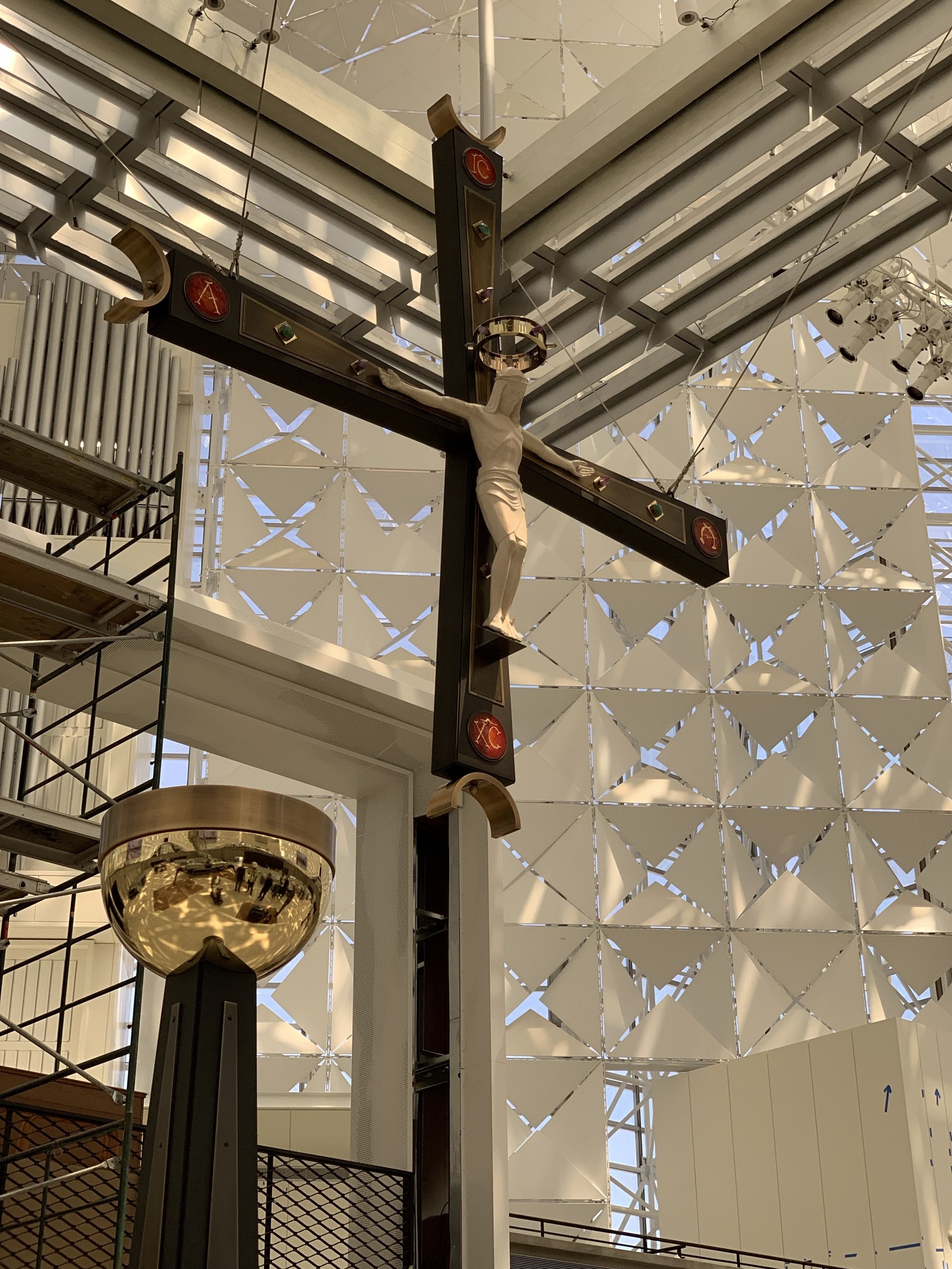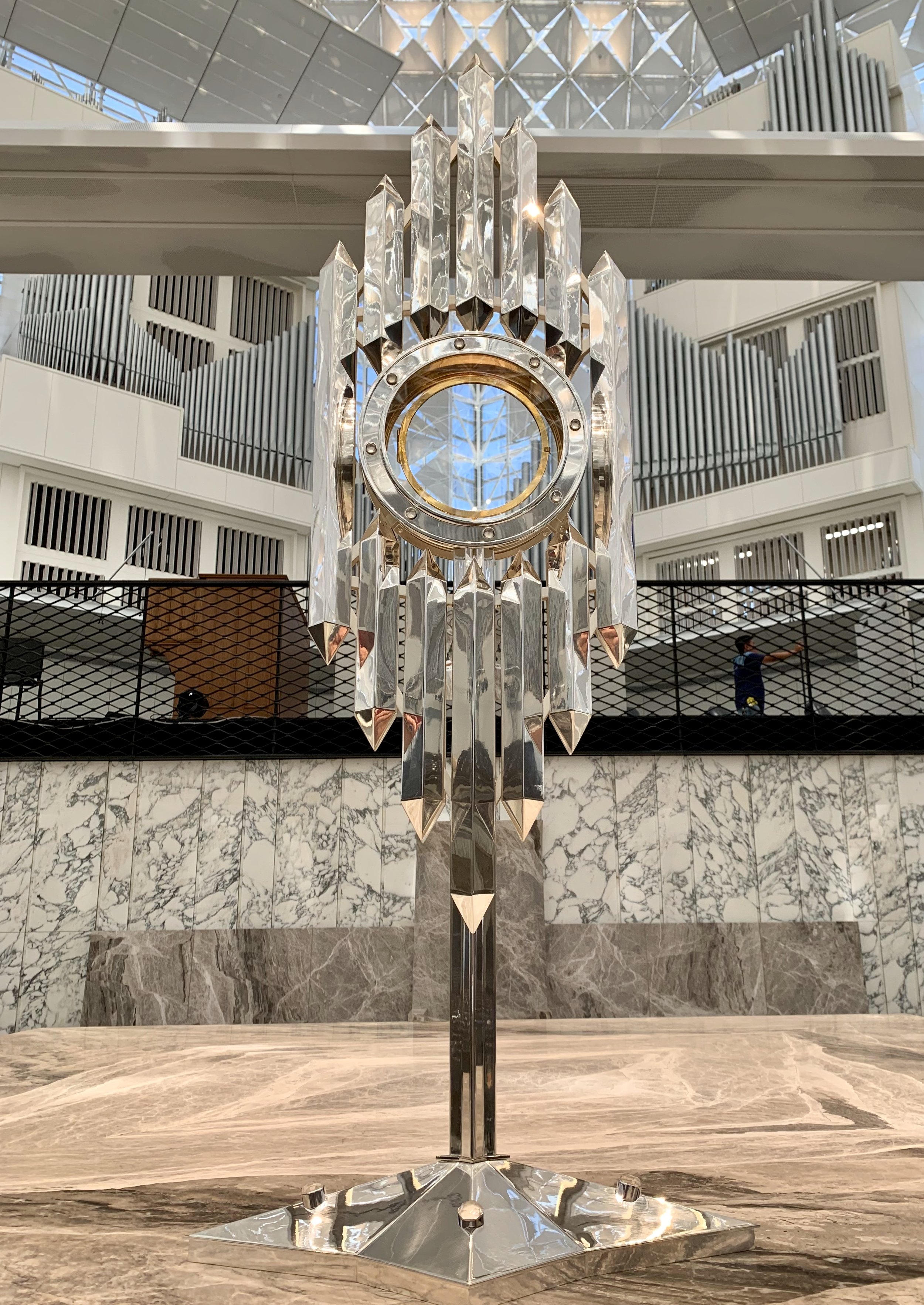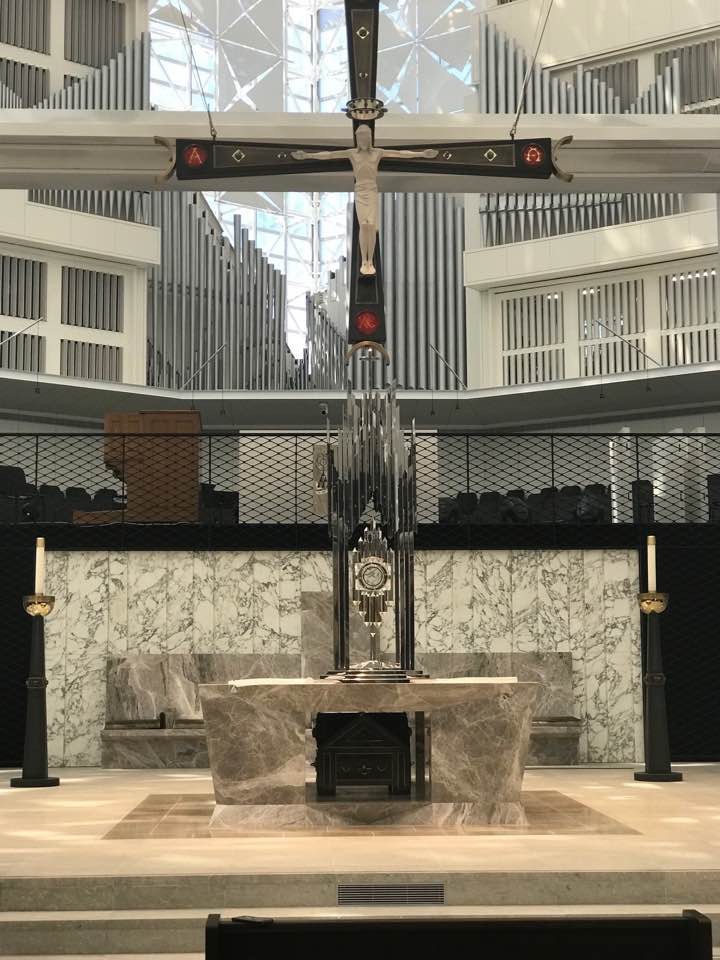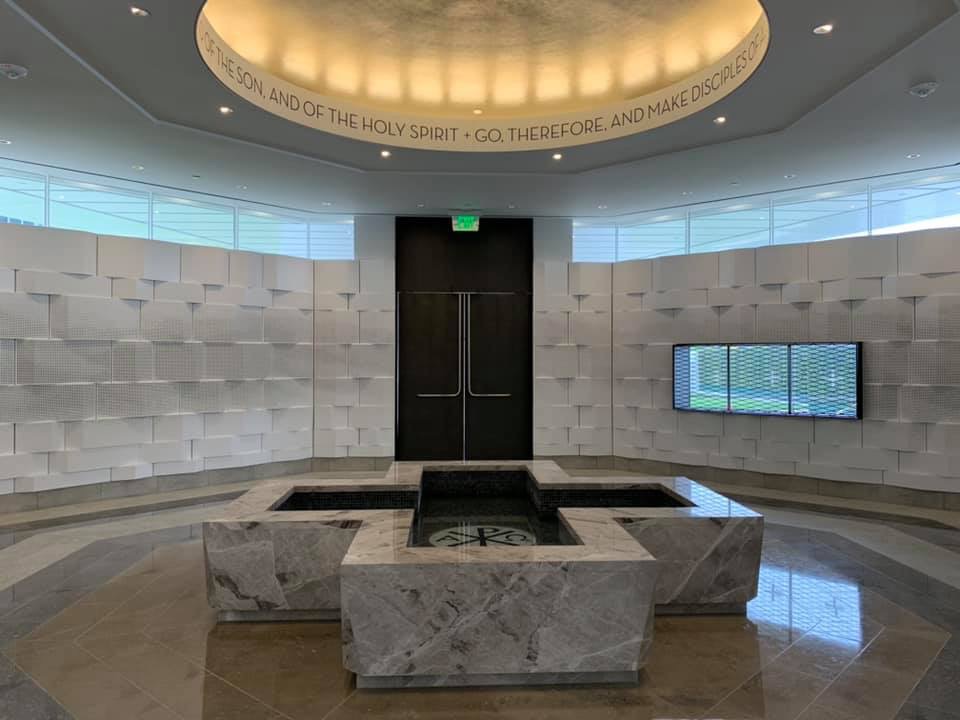Behind the building of any great Cathedral there is inevitably a story. Perhaps not all of them are as creatively intriguing as the one that stands behind the famous novel of some years ago by Ken Follett, Pillars of the Earth, nevertheless, virtually all reflect the story of the creative interplay between faith and imagination, as well as art and architecture, as we attempt to fashion something beautiful in the service of word and worship.
I would like to tell the story that has recently been completed in how the Diocese of Orange has planned, shaped and designed a new Cathedral in light of its relatively recent acquisition of the former Crystal Cathedral and its extensive 35-acre property in Garden Grove, California, into Christ Cathedral.
The campus that is now the heart and center of the 42-year-old Diocese of Orange came about as a result of the acquisition, in 2011 of this 35-acre site of the former Crystal Cathedral site in the heart of Orange County. Why? Sadly, with the bankruptcy and relocation of the once phenomenally successful ministry of the televangelist, Rev. Dr. Robert Schuller, of the Reformed Church of America, the site went up for sale. The Diocese acquired it for a little over 57 million dollars.
On this premier piece of real estate, Dr. Schuller over the nearly 50 years of his ministry, secured three of America’s iconic architects of the 20th century to design not only places for worship but also a strikingly beautiful welcome center.
Richard Neutra designed the first sanctuary or arboretum together with the Tower of Hope between 1961 and 1968. In 1980, the new sanctuary called the “Crystal Cathedral” by Philip Johnson was dedicated.
The final major structure to grace this property was the 57,000 sq. ft., five level Visitors Center designed by Richard Meyer, completed in 2003.
Shortly after the acquisition of the property and its buildings by the Diocese of Orange, visioning began for the eventual transformation of the Philip Johnson structure that would become the new Cathedral for the local Church.
Simultaneous to this visioning, it was necessary to restore the original arboretum sanctuary by Neutra to accommodate the pre-existing, 5000 household St. Callistus parish community that had moved from a nearby location to now form the nucleus of the new Christ Cathedral parish community. The restoration of this beautiful structure to its original pristine form has garnered multiple architectural awards for its sensitive and careful desire to return the structure to its classic Neutra design.
The work on transforming and repurposing the Philip Johnson structure began in earnest in 2012 with the hiring of Br. William Woeger, a Christian Brother and Director of the Office of Worship in Omaha, to function as the principal liturgical consultant on the project. Bringing with him over 40 years of experience in liturgical design and Cathedral renovation, Br. William worked closely with the newly formed Architecture and Renovation Committee for Cathedral design in eventually assisting in securing two Los Angeles based architectural firms, Johnson Fain and Rios, Clementi, Hale. With the architects in place, they and their teams now became actively engaged in the synergistic process that brought together sacramental theologians, liturgists, artists, architects and designers to eventually bring about the transformation of this site from Crystal to Christ Cathedral.
The challenges we faced in repurposing this structure were innumerable:
· Respect for the architectural lines and genius of Johnson’s original structure
· Moving from a Word centered space geared toward televangelism and an entertainment model of worship to
· A place of sacramentality, were the traditional ritual interplay between the centrality of the Eucharistic Table, the Proclamation from the Table of the Word, and the episcopal presidency of the one at the cathedra would now take center stage.
· The judicious integration of sacred iconography within a space that was visually opened completely to the outside environment
· Taming hostile temperature variances that in the summer could range from 80 degrees at the floor level to 110 degrees in the upper sections of the Cathedral
· Restoration of one of the great pipe organs of the world that had experienced 30 years of these temperature fluctuations.
· Creating a ritual, liturgical and architectural ‘center’ for the Cathedral building itself in a campus that incrementally grew somewhat topsy-turvy over the years, without a specific focus.
These and countless other ‘surprises’ were the ‘stuff’ of the monthly meetings of our team as our discussions and visioning led to preliminary designs, concepts and approaches. These were then further refined and discussed in subcommittees, leading eventually to the completed design concept that is now in place, the fruit of a year and a half birthing process. The process itself became a transformative experience for liturgists coming to know more of the dynamics of architecture and architects and designers coming to understand the place of sacrament and symbol in the shaping of a House for the Church.
In her recently published book, St. John’s Abbey Church: Marcel Breuer and the Creation of a Modern Sacred Space, Victoria Young tells the story of the planning and building of this architecturally significant contemporary church structure in Collegeville, Minnesota.
It was the positioning and orientation of the Table of Sacrifice that orchestrated the eventual positioning of all the other symbols for worship. So it was for Christ Cathedral. After reviewing a number of different orientations for the Altar it was initially strongly felt that the Catholicity of this unique project of transformation called for the positioning of the Table of Sacrifice within the axis mundi of the Johnson structure.
This initial conceptualization, clustered the assembly in antiphonal seating to its right and left and positioning the ambo at one end of the centrally raised predella and the cathedra at the other end – the three primary symbols would now be liturgically, ritually and visually at the center of the structure with a seating capacity of 2100.
While this design had its liturgical precedents within primarily monastic communities, it was subsequently wisely felt that such a ‘radical’ design would be too disengaged from the ordinary worship experience of the faithful in the parishes of the Diocese. Hence, at the behest of the Bishop of the Diocese, a slight modification was made in this original orientation, moving the Altar slightly back creating a more fan-like seating arrangement for the assembly with the Ambo off to the right side of the worship area.
To underscore the permanence of these central symbolic elements of Altar, Ambo and Cathedra, they would be crafted in travertine marble quarried from Turkey and finished in Italy.
Under the altar we have enshrined a reliquary house, ornamented in semi-precious cabochon stones that holds the relics of martyrs, specifically, the North American, Vietnamese, Korean and Mexican martyrs that have a special place in the hearts of the culturally diverse faithful of the Diocese. To acknowledge the proto-evangelizer of Orange County, a relic of St. Junipero Serra, founder of the historic mother church of the Diocese, Mission San Juan Capistrano (1776), will also be housed in the reliquary.
To give visual focus to the table in an expanse that is over 100 ft high, is a suspended baldachino, leafed in antique platinum with an oculus opening to the sky.
From the oculus is suspended the crux gemmata, in polished bronze and ornamented in semi-precious stones of lapis lazuli, carnelian, malachite, polished quartz crystal, with a large corpus in bleached wood in the Beuronese style reminiscent of the late 19th century. Capturing the Johannine theme of Christ enthroned in glory on the triumphant cross of victory, the head of Christ is surmounted by a precious crown.
Sanctuary Appointments
Great care was taken in the design and crafting of the sanctuary appointments, beginning with the principal symbols of altar, ambo and cathedra. Because of the distant sight-lines from the twin transept balconies, appropriate proportion was of paramount importance. It is for that reason that the marble altar is crafted in a generous 8’ square. As the Table of the Word, the ambo is equally generously proportioned. Reminiscent of many of the ancient Basilicas, a permanent paschal candle stand, crafted in matching marble and ornamented in semi-precious stones is positioned next to the ambo.
Post-conciliar liturgical directives clearly state that the cathedra should avoid any reminiscence of an imperial throne but rather should in noble simplicity be the place where the shepherd-servant presides over Word and Sacrament. The designers integrated the simple cathedra into a ‘presbyterium’ bench, with the episcopal coat of arms of the bishop demarking his chair.
Finally, the four altar candle holders are of similar substantial proportion and are positioned in such a way as to highlight the holy table.
The ritual of Dedication specifies that 12 (or 4) candles grace the walls of the dedicated church to mark the place of chrismal anointing. The designers choose 12 hanging lamps that surround the interior wall of the cathedral, symbolizing the 12 apostles to mark the places of anointing.
Iconography, Sacred Vessels and Vesture
In transitioning from a primarily Word centered worship space to a highly liturgically oriented place of sacramentality within the Catholic Tradition, the place of sacred imagery together with all the other areas enriching the Catholic liturgy, i.e., sanctuary furnishings, sacred vessels and vesture, took on pivotal importance in the repurposing of the Philip Johnson structure.
The newly established Sacred Arts Committee reviewed artistic submissions by a number of potential liturgical artists as a plan was developed for the use of sacred imagery within the Cathedral. The Committee commissioned Pablo Eduardo, a native Bolivian, for the majority of the artistic enhancement within the Cathedral.
Pablo Eduardo
Eduardo was commissioned to craft the four primary images in bronze of the “Manifestations of the Divinity of Christ” surmounted on the encircling walls of the Cathedral. Drawn from Gospels, the images are: The Epiphany, The Baptism of the Lord, The Wedding Feast in Cana and The Transfiguration. These images will be installed later in the year.
Baptism of the Lord by Pablo Eduardo
Together with the Manifestations, Eduardo crafted the 14 Stations of the Cross as well as the bronze bas-reliefs that will be on the primary Festive doors of the Cathedral and on the interior Narthex wall.

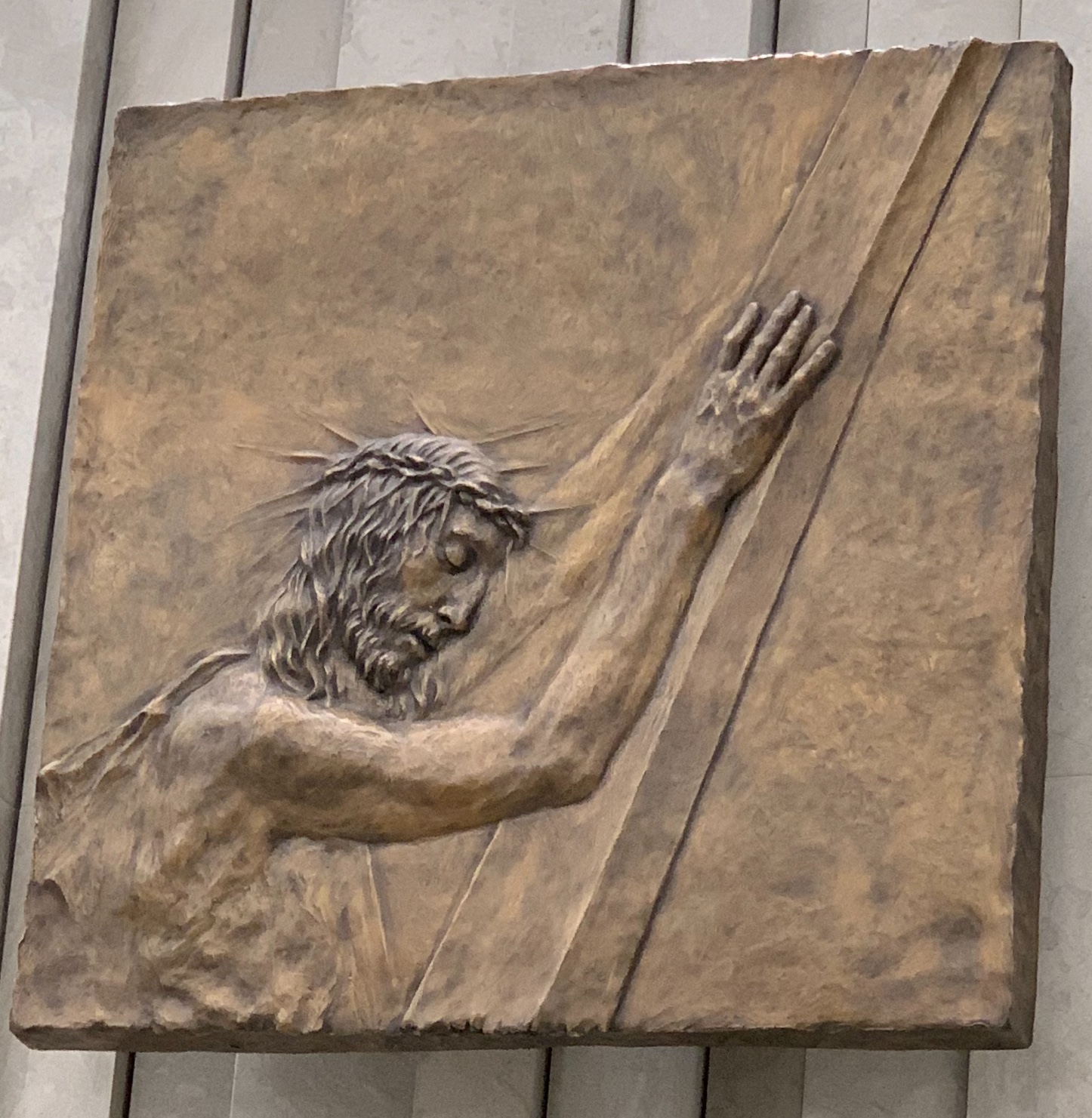
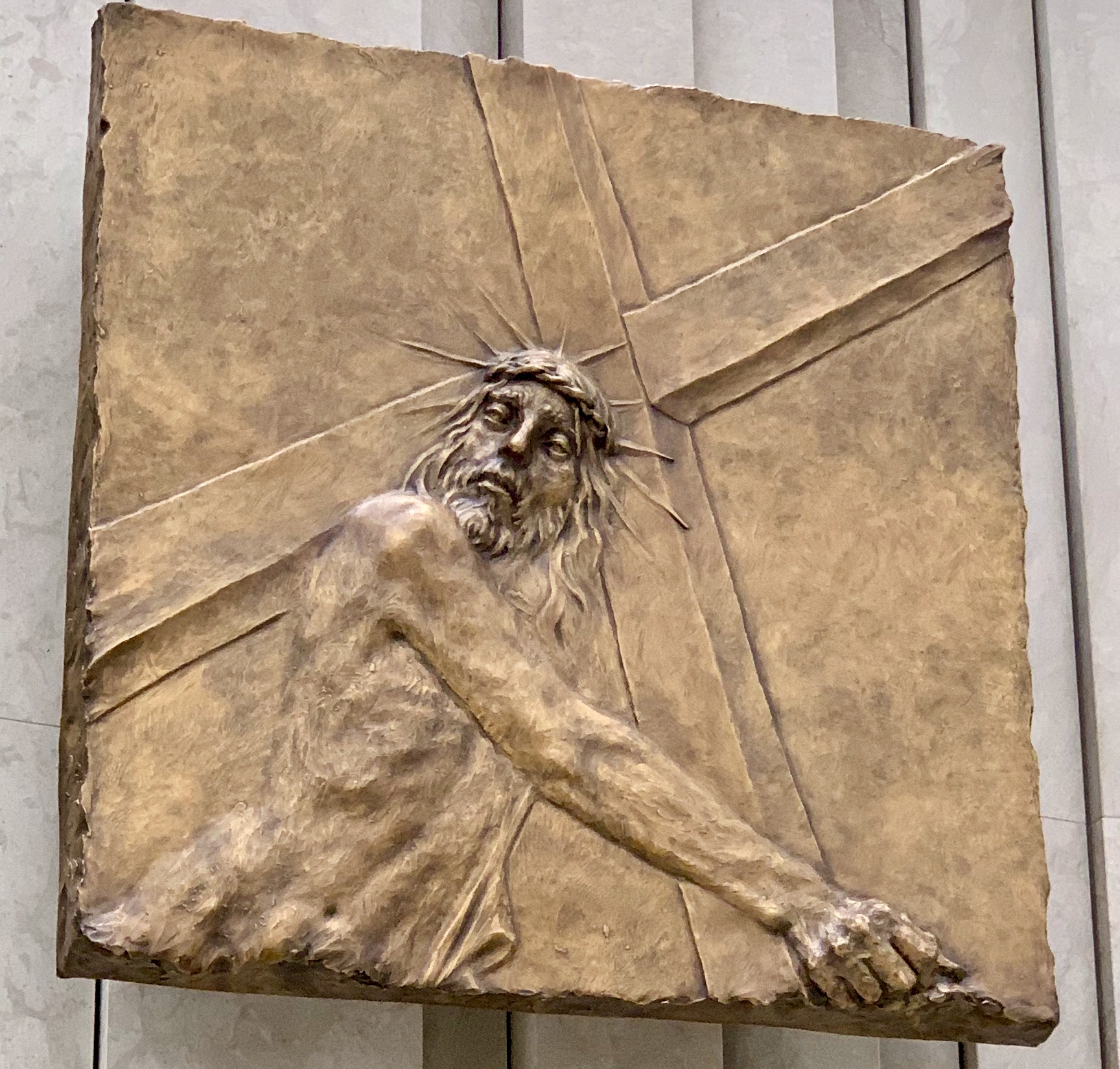
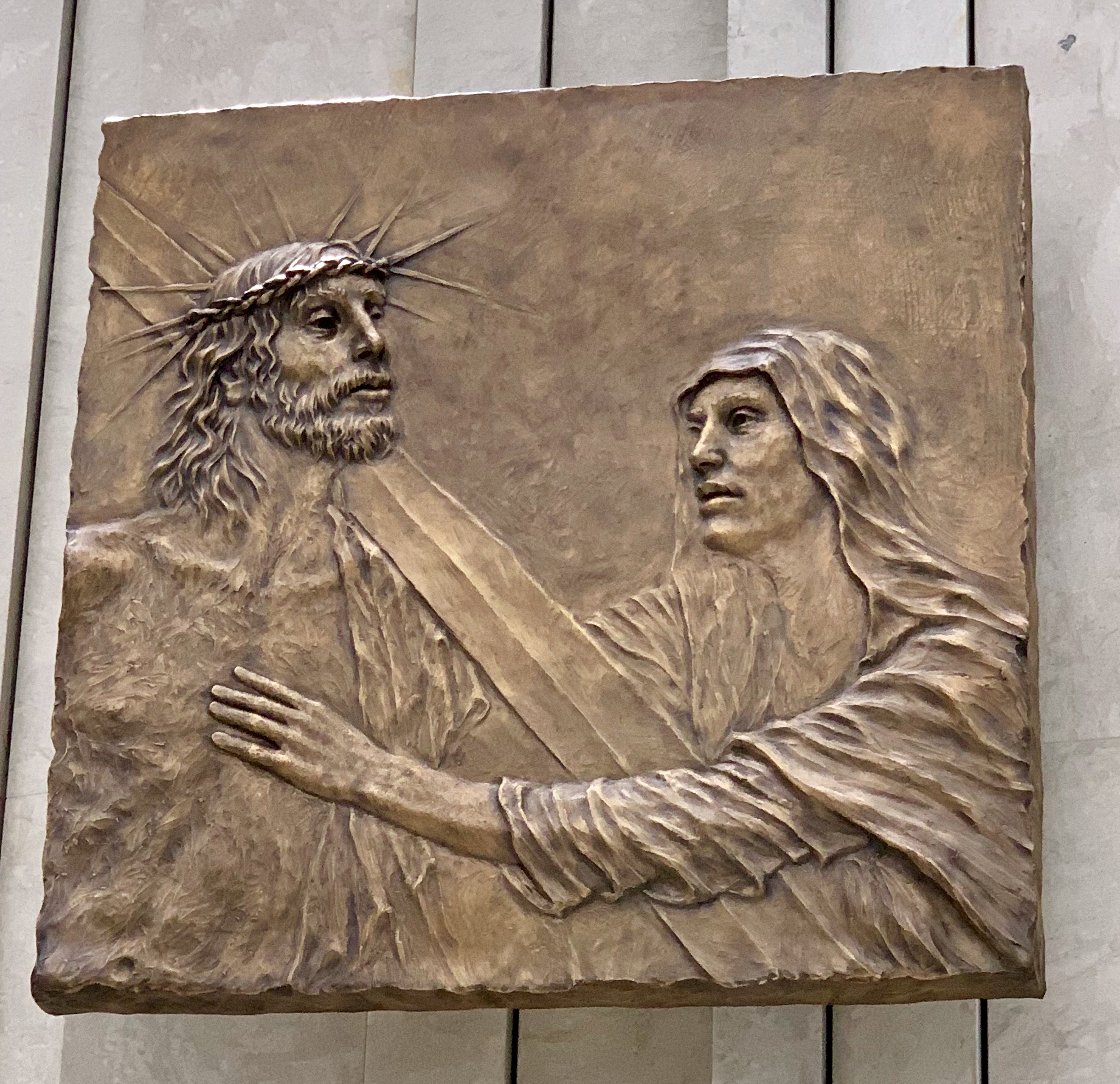
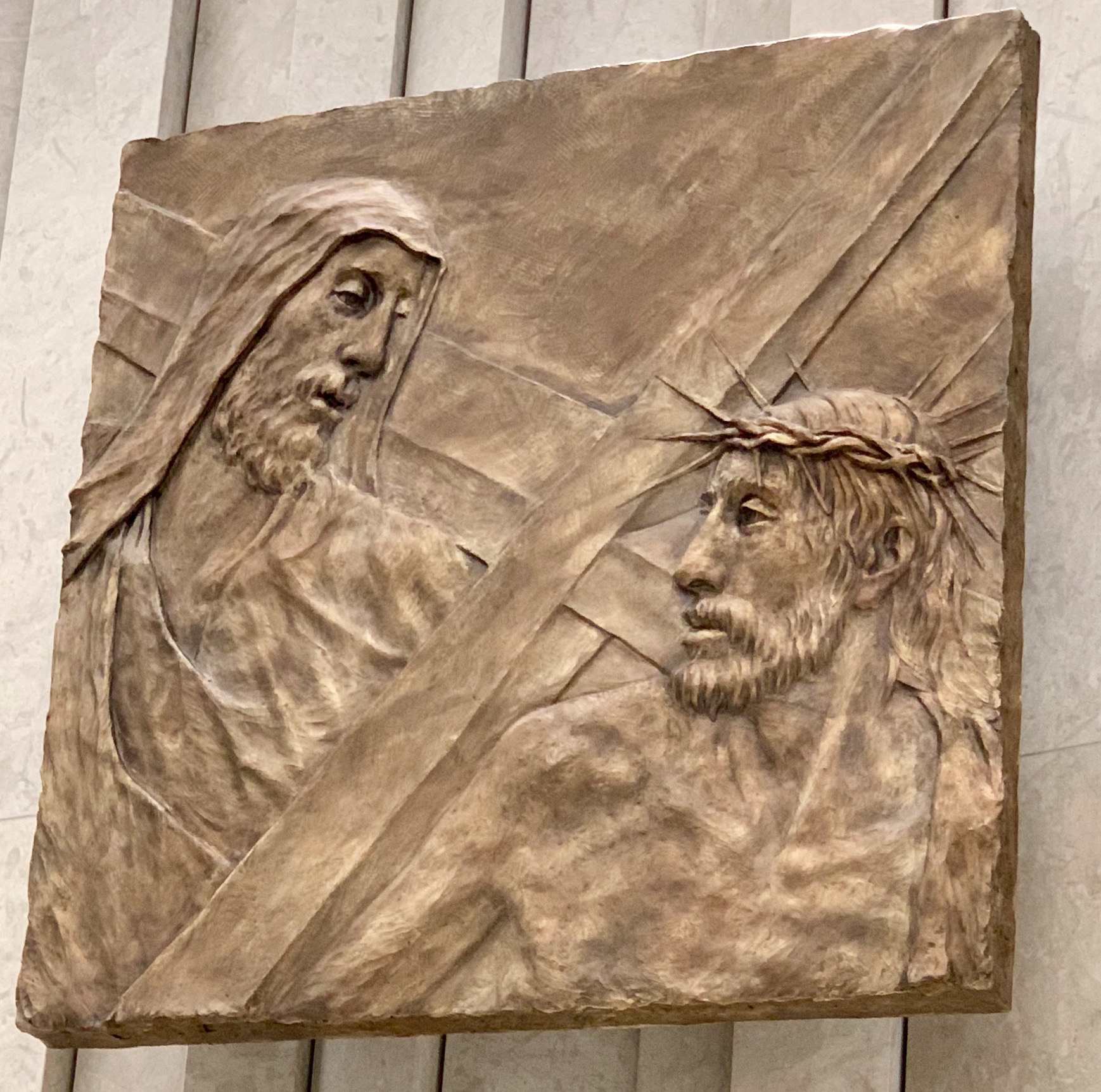
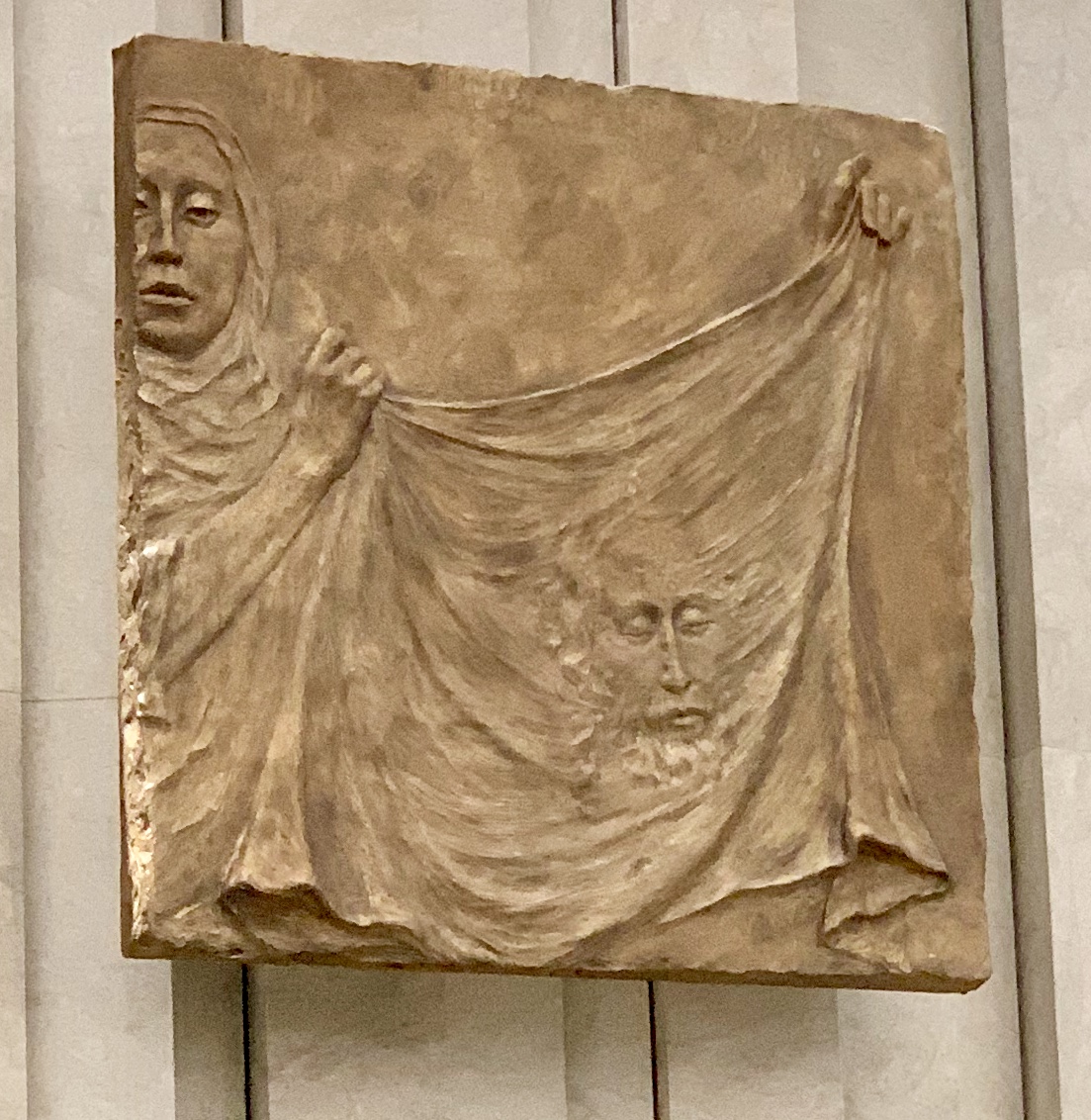
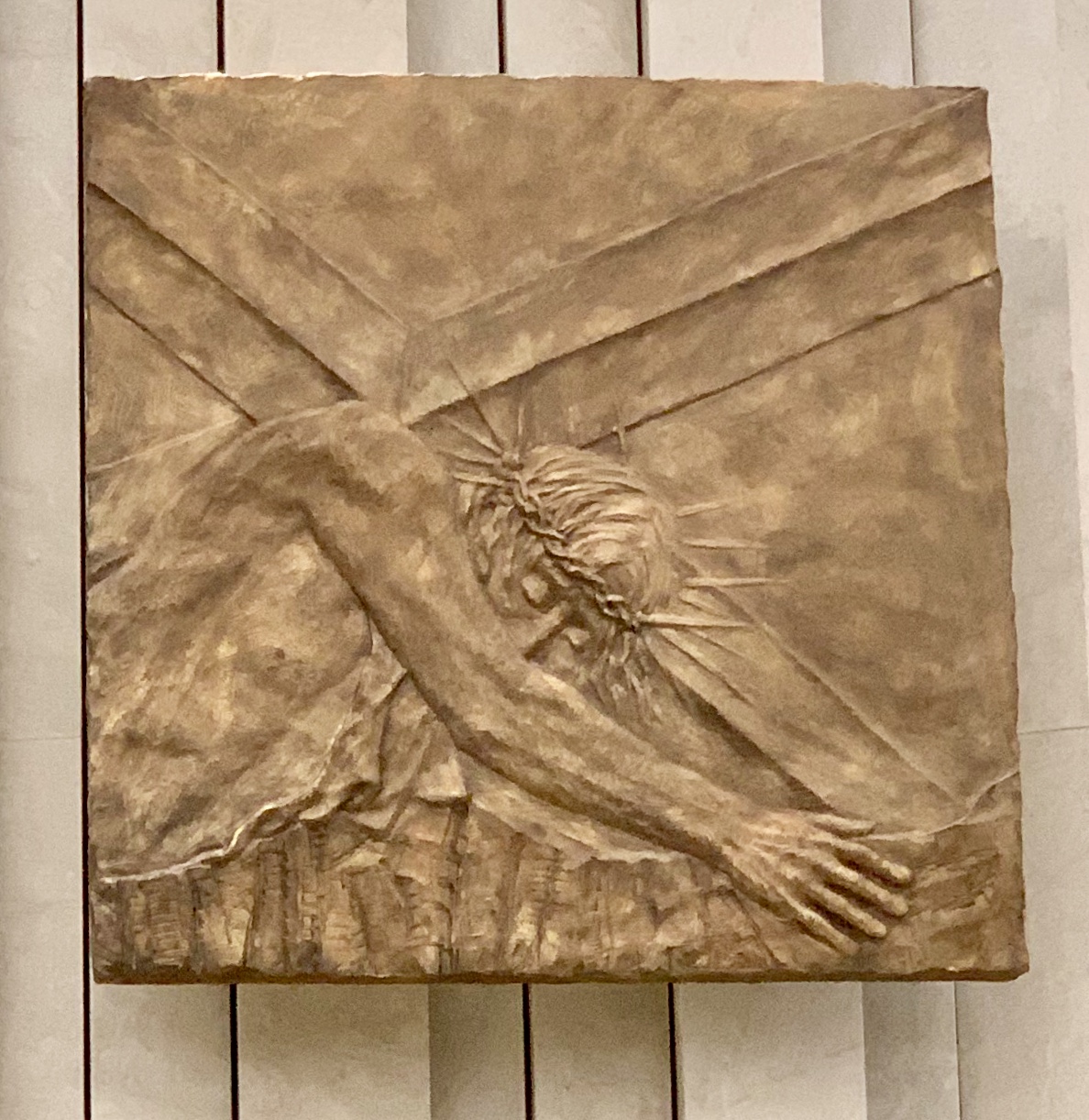
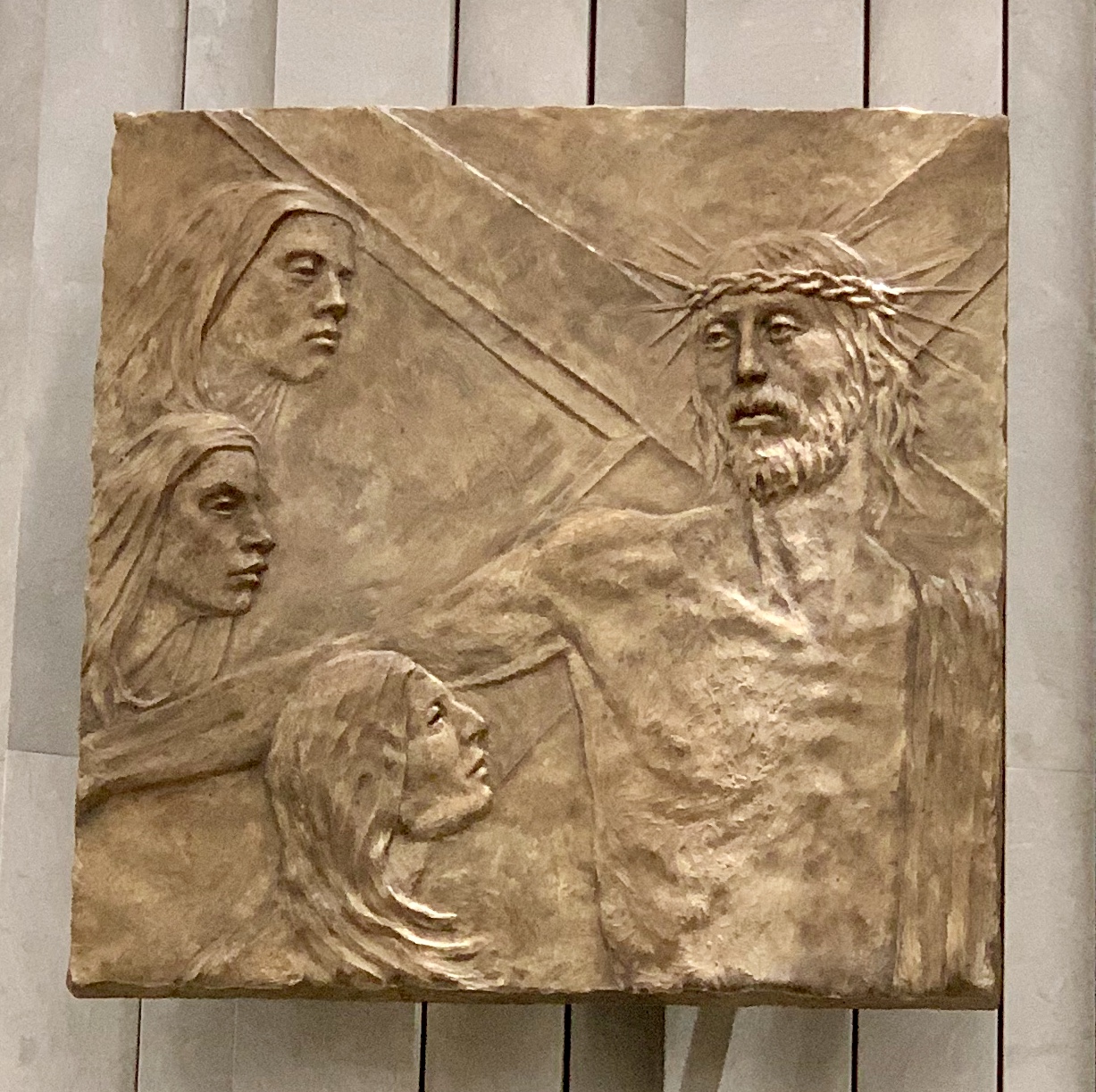
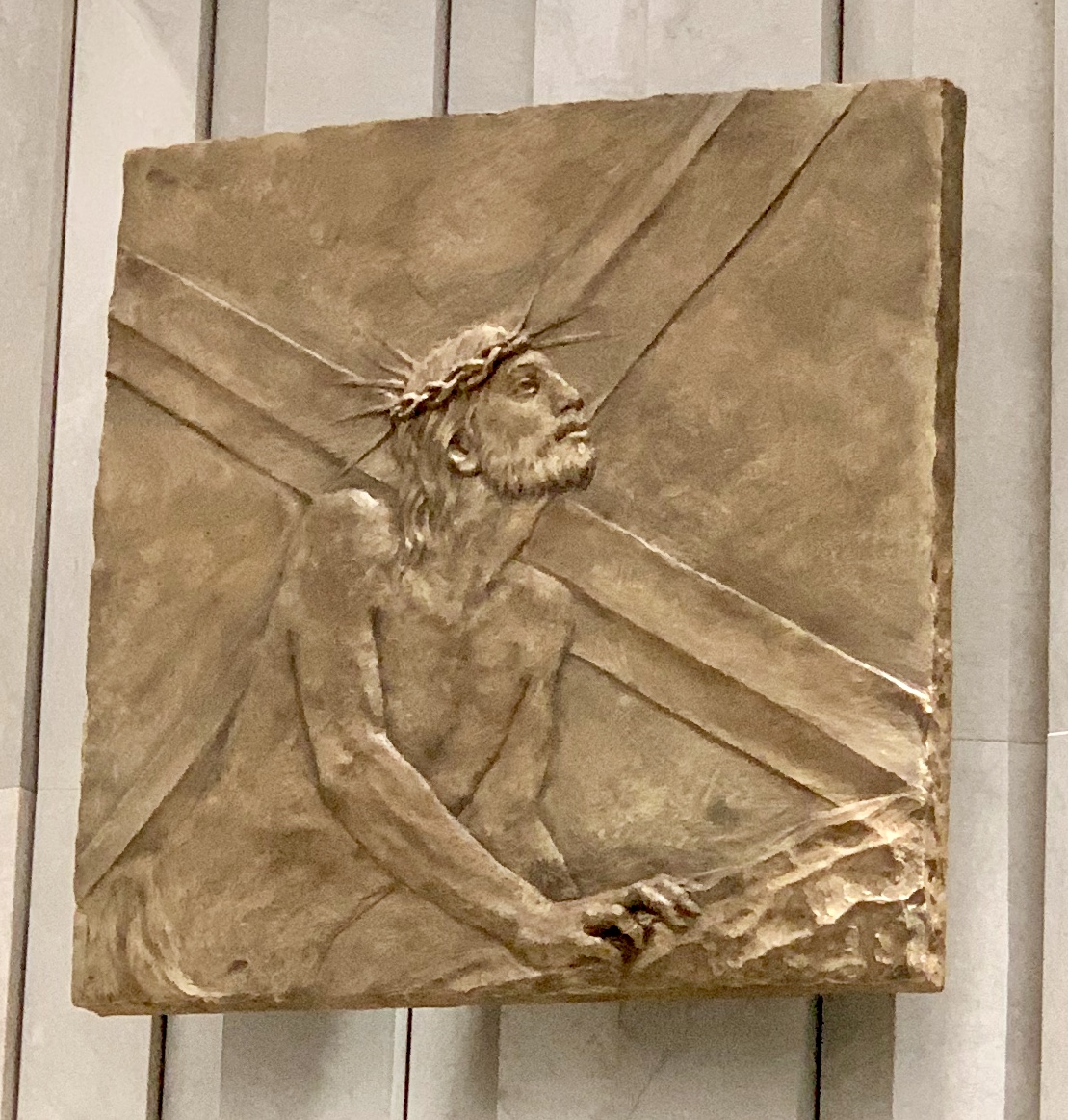
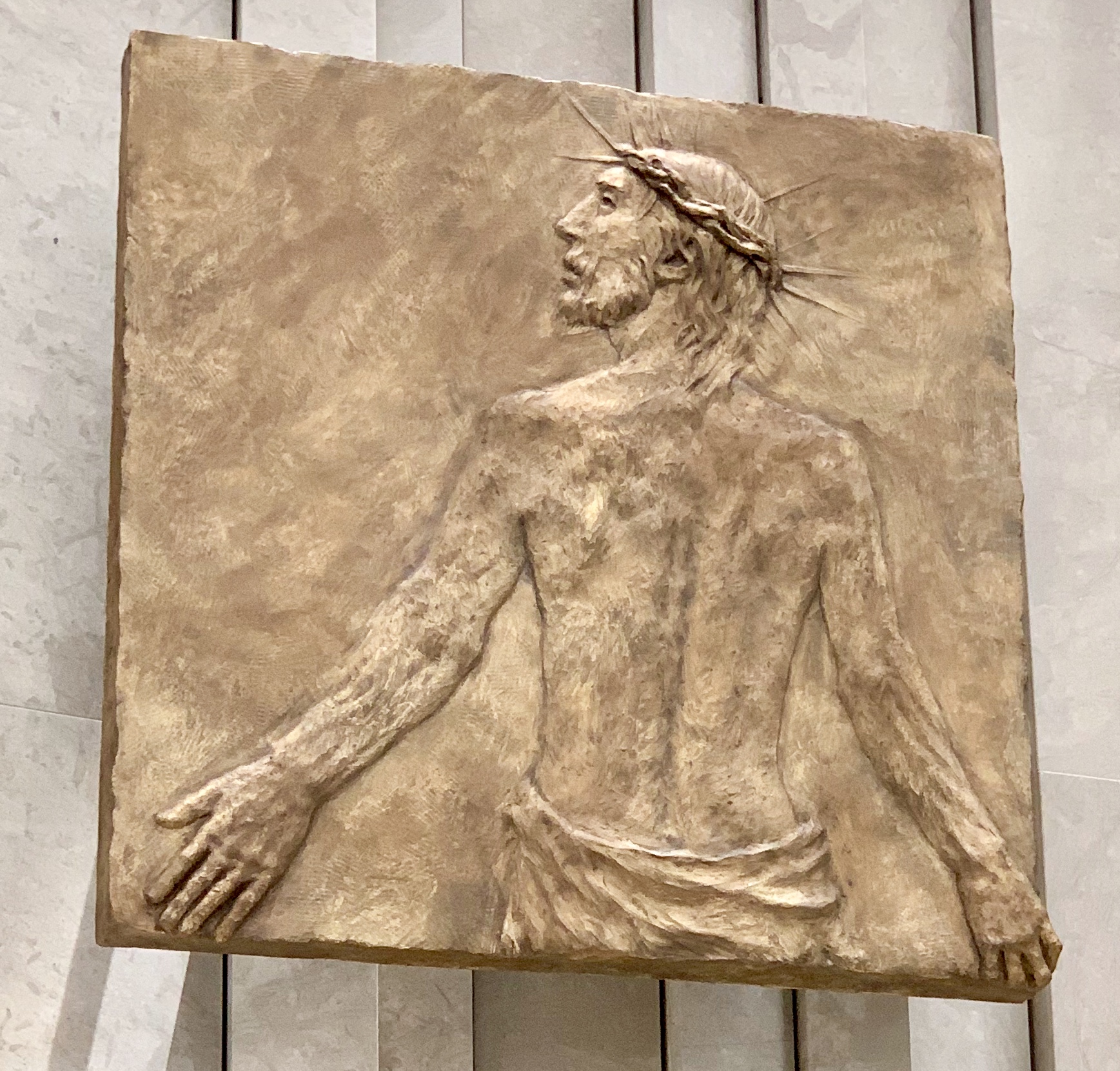
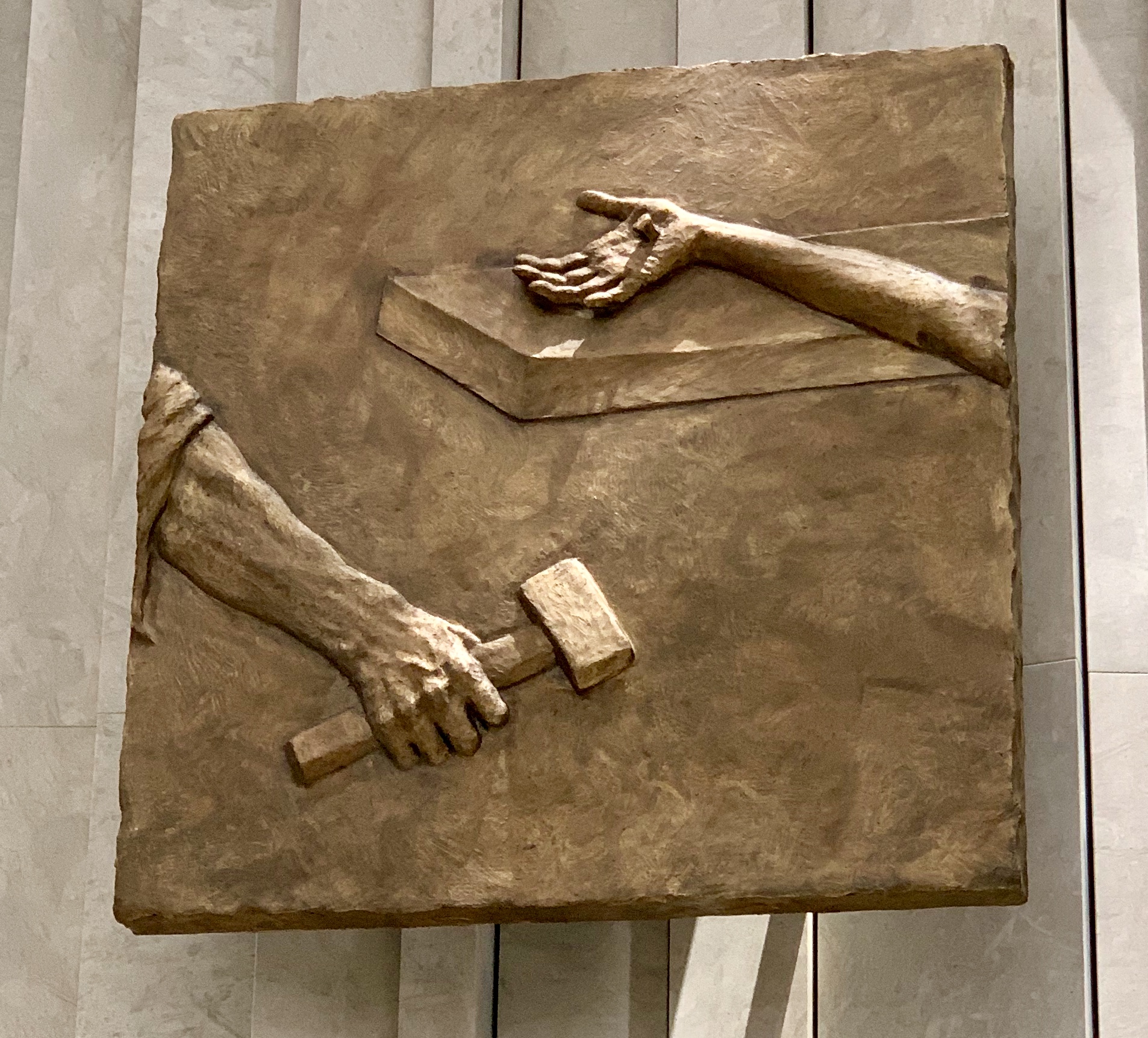
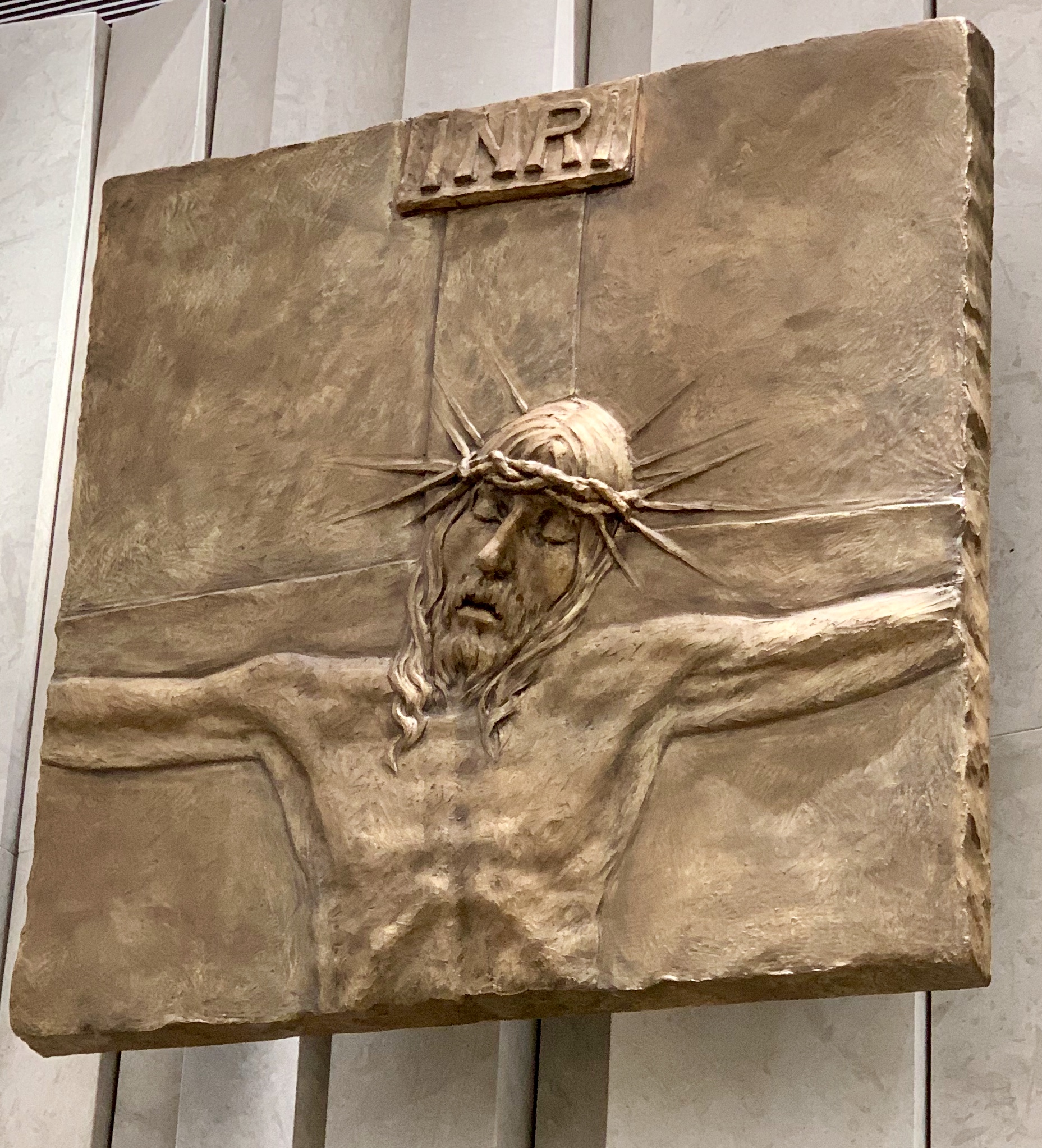

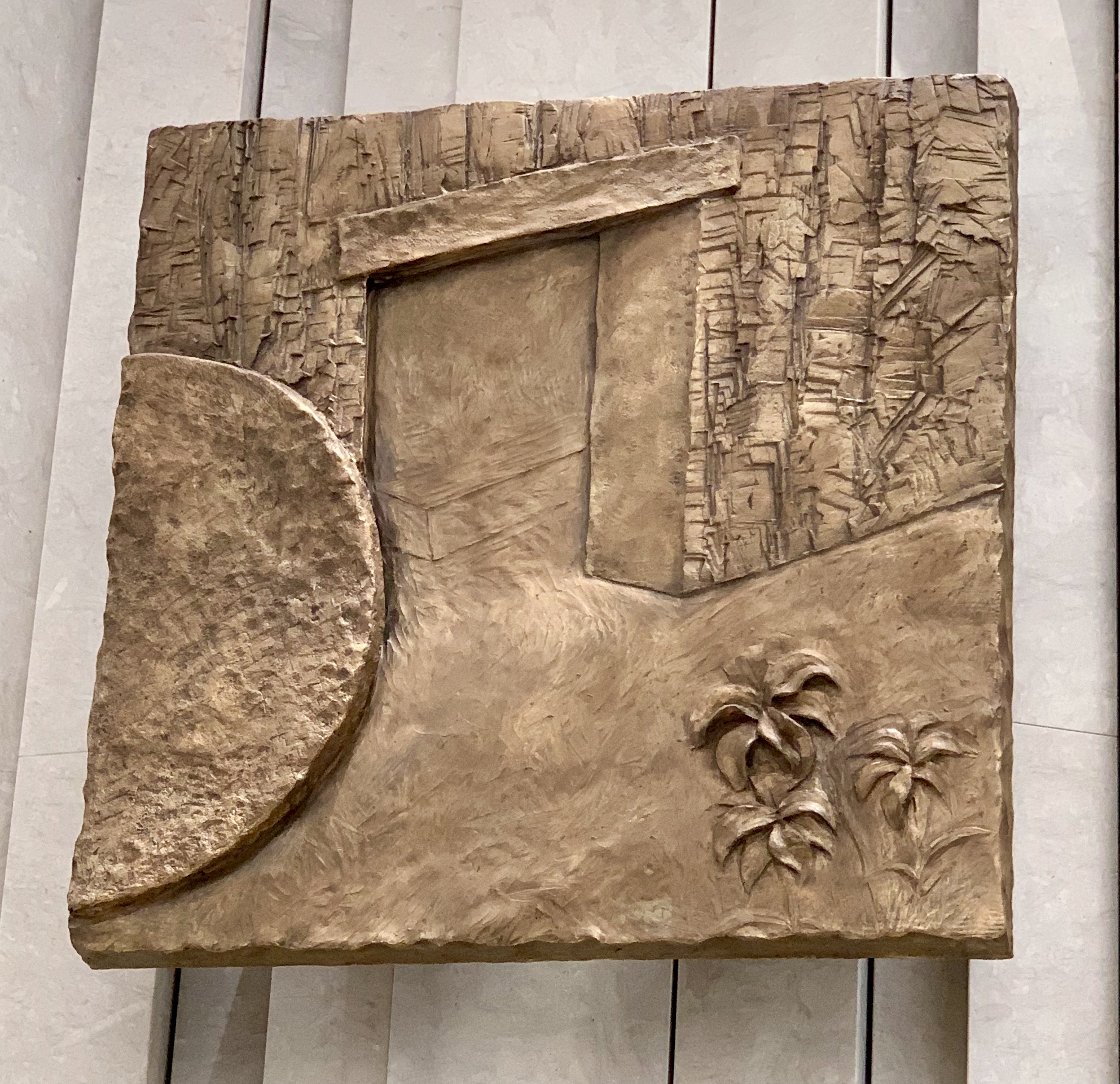
Festal Doors - Expulsion from Paradise by Pablo Eduardo
As the doors pivot open, the interior narthex wall hold an additional bronze low-relief sculpture depicting the Communion of Saints before the Lamb of God.
The monumental tapestry of the titular image of Christ, Lord of Creation, designed by Br. Martin Erspamer, O.S.B., is hung in the interior of the Cathedral to the right of the sanctuary area. Its bright colors create an iconic focal point to the otherwise monochromatic colors within the Cathedral interior.
Christ seated in Glory by Martin Erspamer, O.S.B.
Image of Our Lady of Guadalupe
With the establishment of the Diocese of Orange in 1976, the founding Bishop, William Johnson, petitioned the Holy See to name the Diocese under the patronage of Our Lady of Guadalupe. Since that time, the venerable image of Our Lady under this important title has had a prominent place in virtually every parish in the Diocese. It is only fitting that in Christ Cathedral her image would have a prominent place.
Enshrined on the opposite side of the Narthex wall and among the assembly facing the Table of Sacrifice, Mary, the first Christian and Empress of the Americas, will have a place of appropriate prominence in the Cathedral Church.
Crafted in exquisite mosaic by the internationally renowned Italian artist, Valerio Lenarduzzi, with ample area for the veneration of the faithful, the image of the Mother of God takes its place among the images of the holy ones in the House of the Church.
In order to maintain artistic continuity and excellence with the Cathedral’s contemporary design, sacred vessels were commissioned and designed by Talleres de Arte Granda in Spain to complement the liturgical action at the Holy Table. Crafted in hammered and highly polished silver and embellished with cabochon semi-precious stones, the episcopal chalice together with communion chalices and ciboria as well as a unique and highly creative design for the Cathedral monstrance and it’s baldachino, bring dignity and beauty to the life of worship in the Cathedral.
Sacred Vessels
Presentation ciborium
Reservation Ciborium
Custom monstrance for Christ Cathedral
Monstrance with monumental baldacchino
Finally, the Committee commissioned The Holy Rood Guild in Spencer, Massachusetts, to design and craft the sacred vesture to compliment the liturgical celebrations for all seasons in the Cathedral. A special design in white for the Bishop, Deacons, principal concelebrants and 200 presbyteral concelebrants was commissioned and gifted to bring dignity to major diocesan celebrations.
Blessed Sacrament Chapel and Tabernacle
To the East of the assembly area will be the Chapel of Eucharistic Reservation. The Tabernacle or Sacrament tower, is by the 20th century German enamelist, Egino Weinert, positioned on a pedestal of bronze that depicts images from the Gospels.
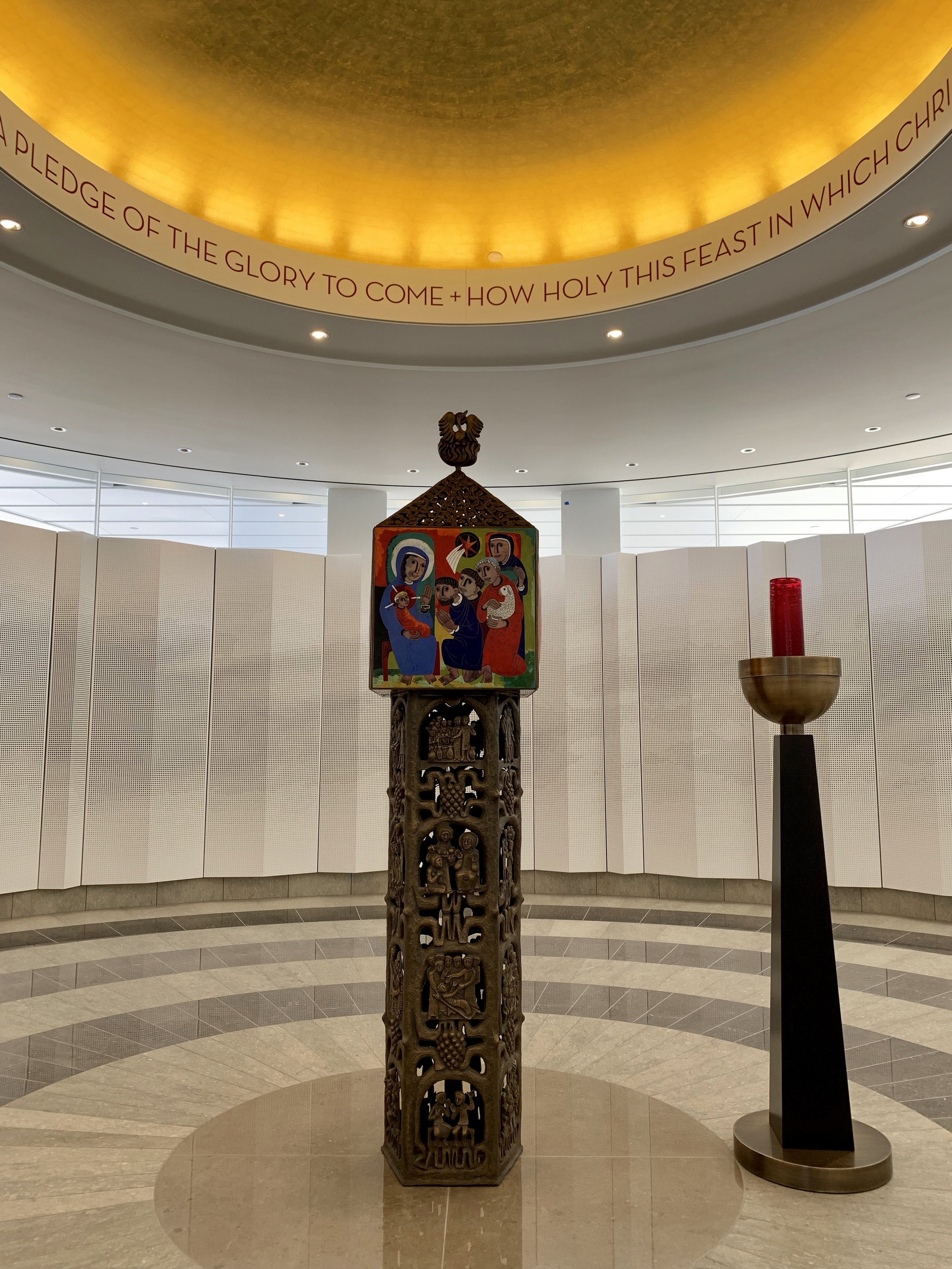
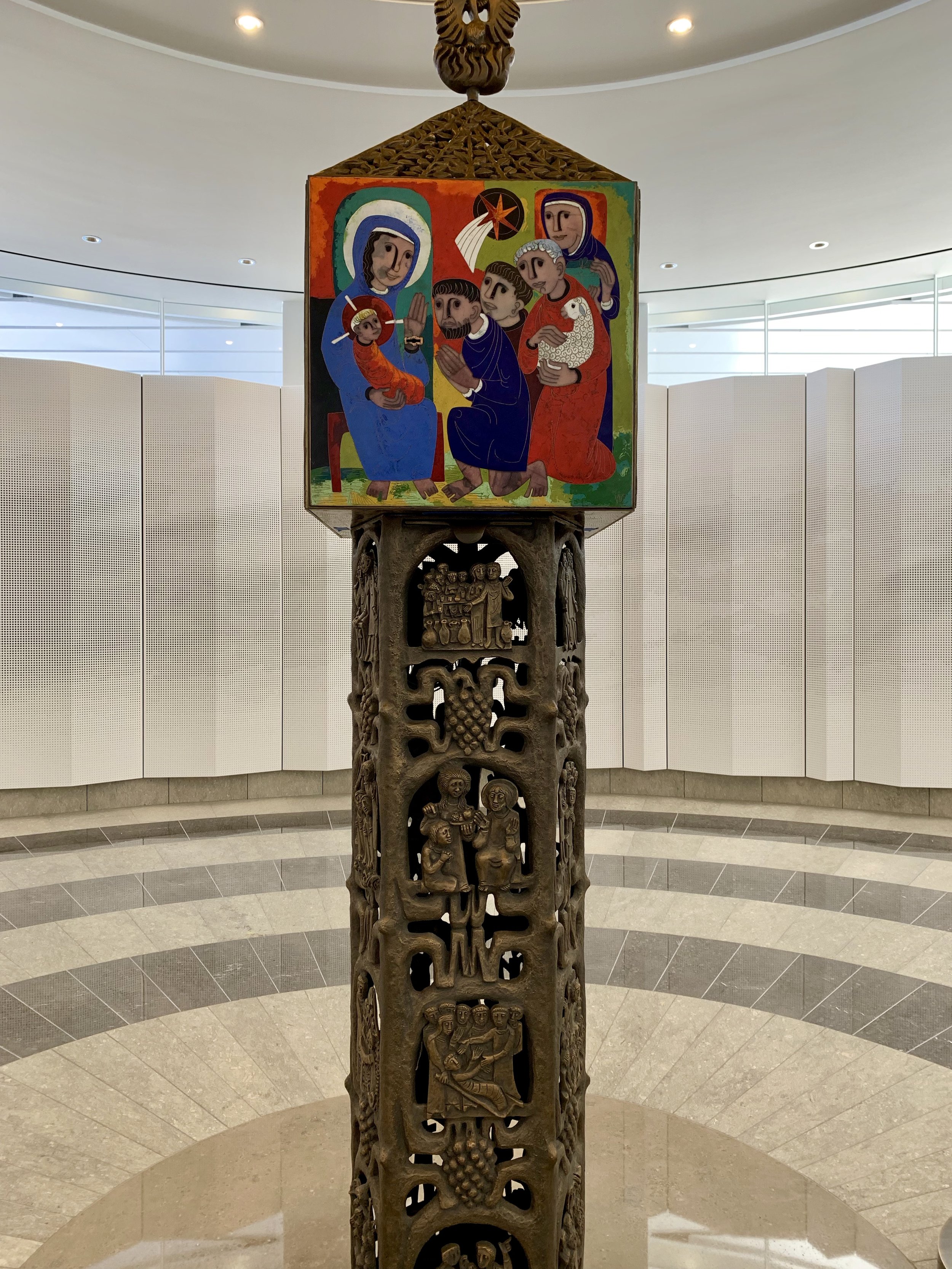
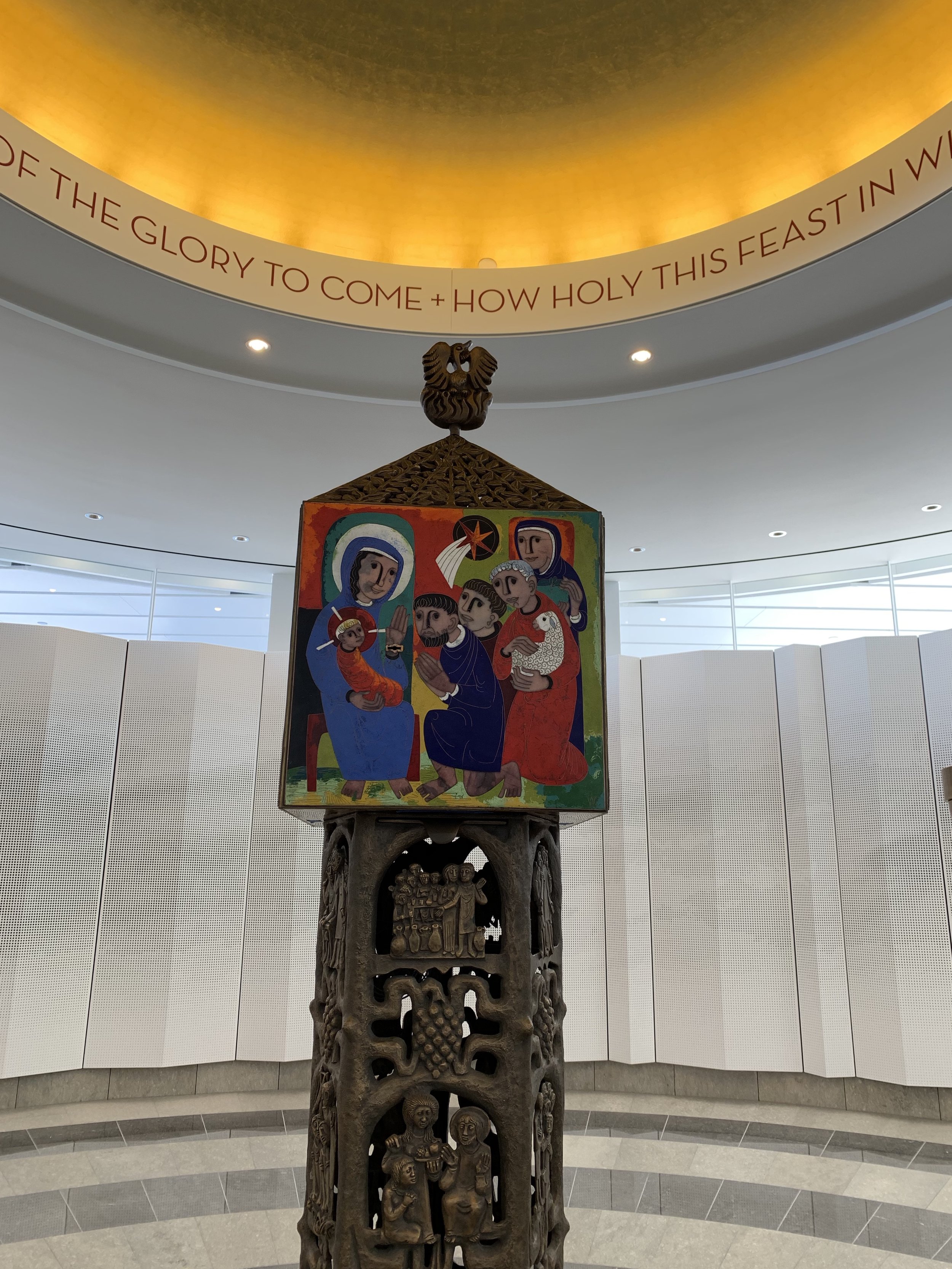
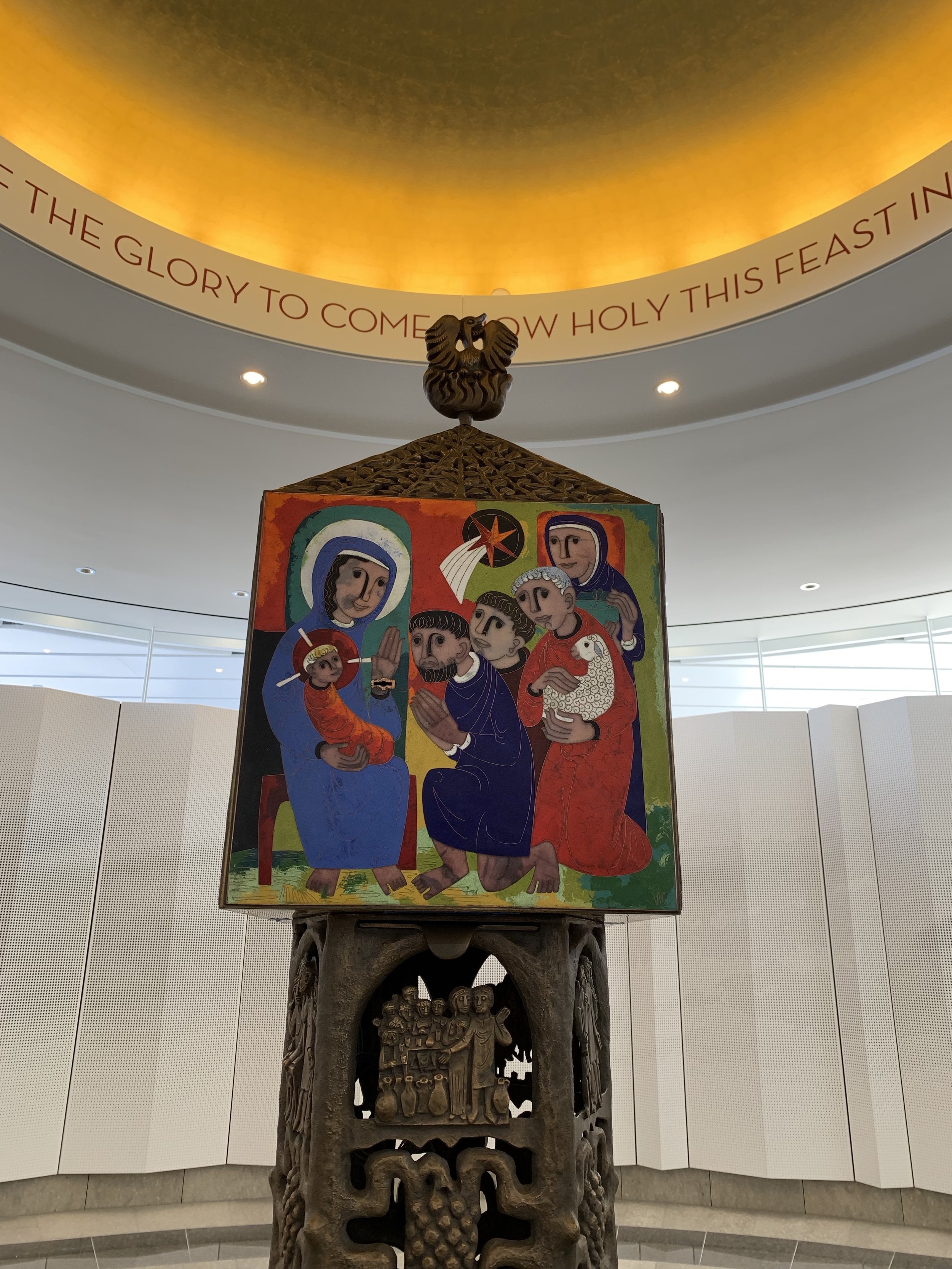
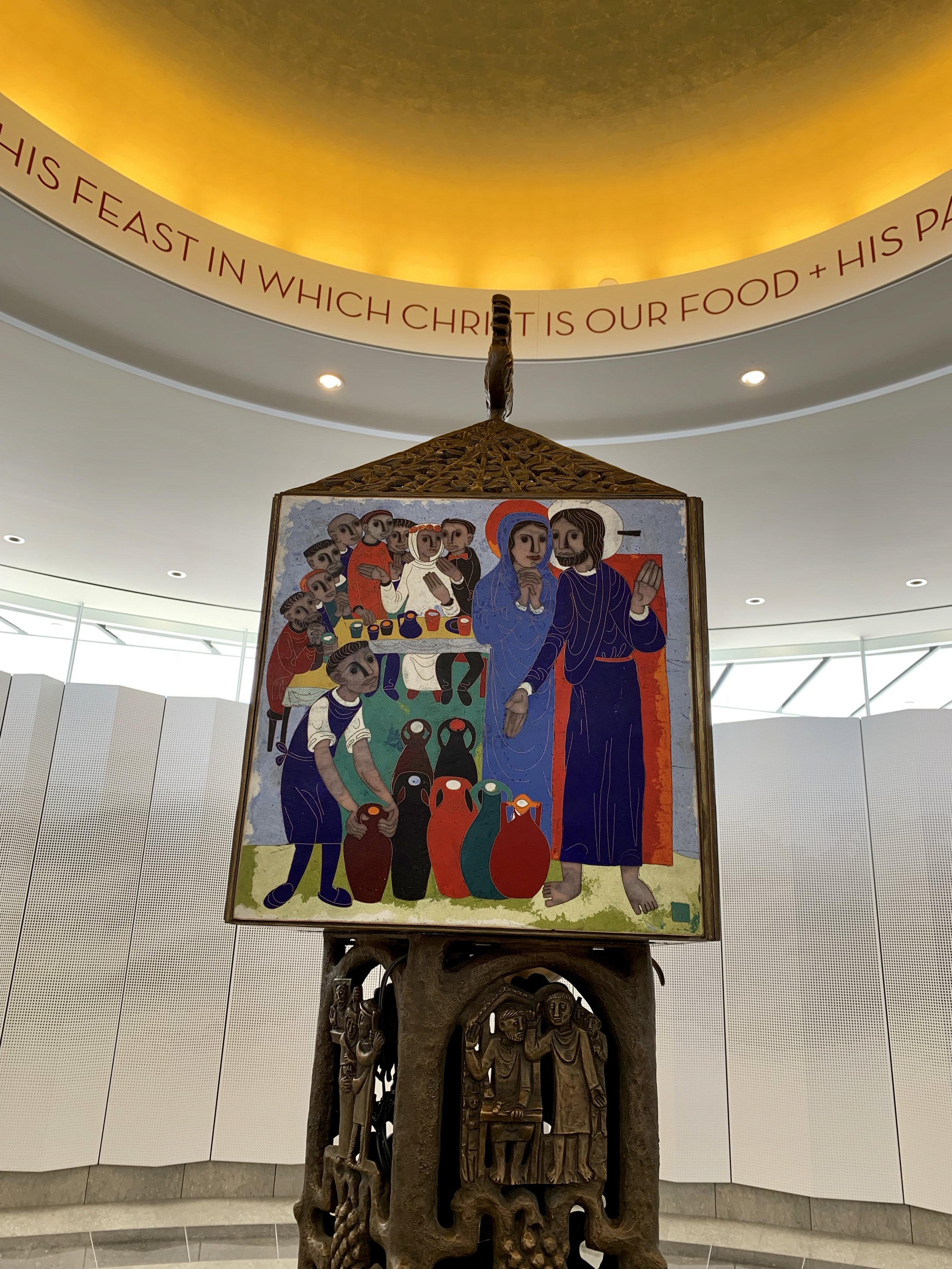
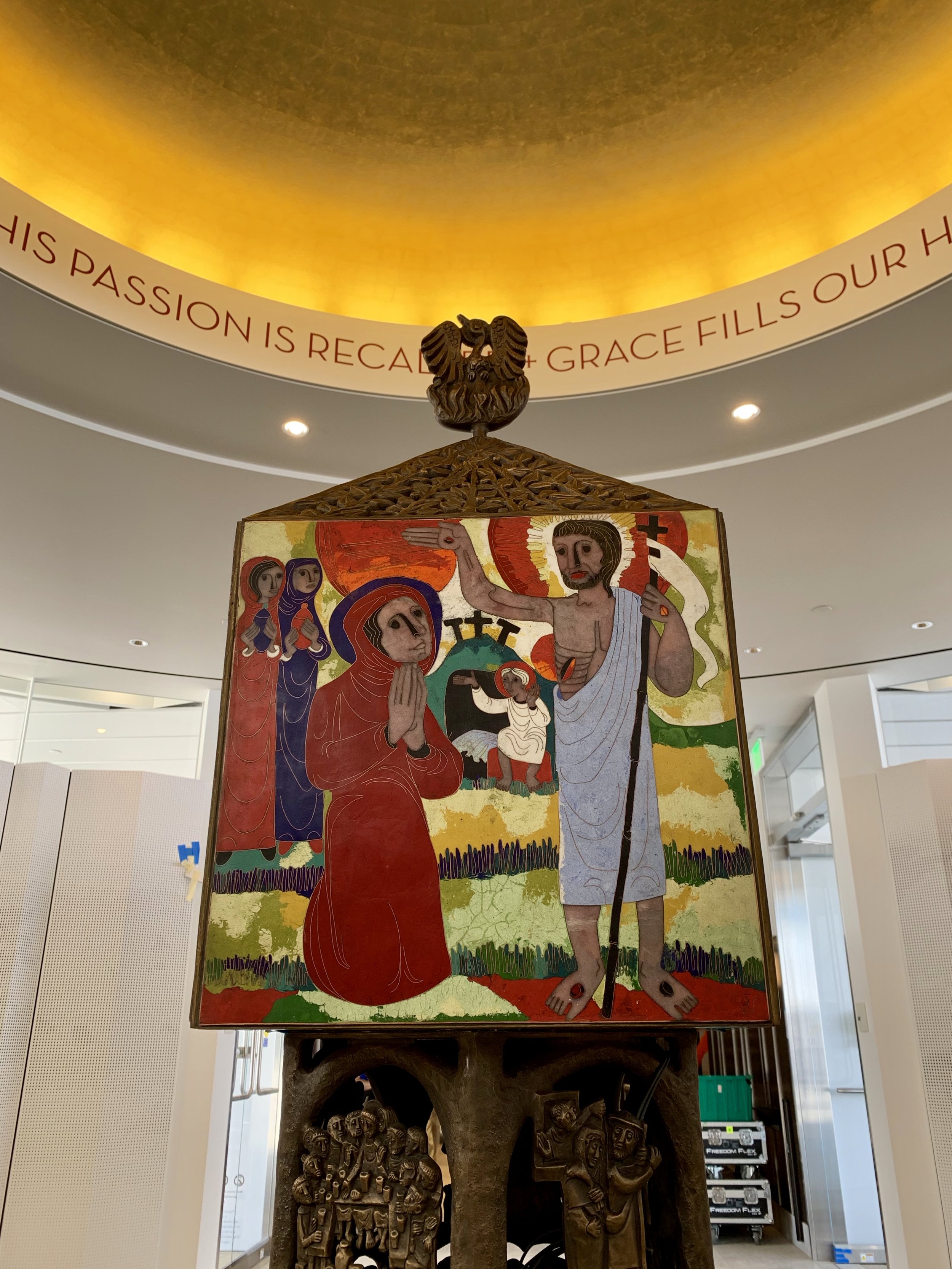
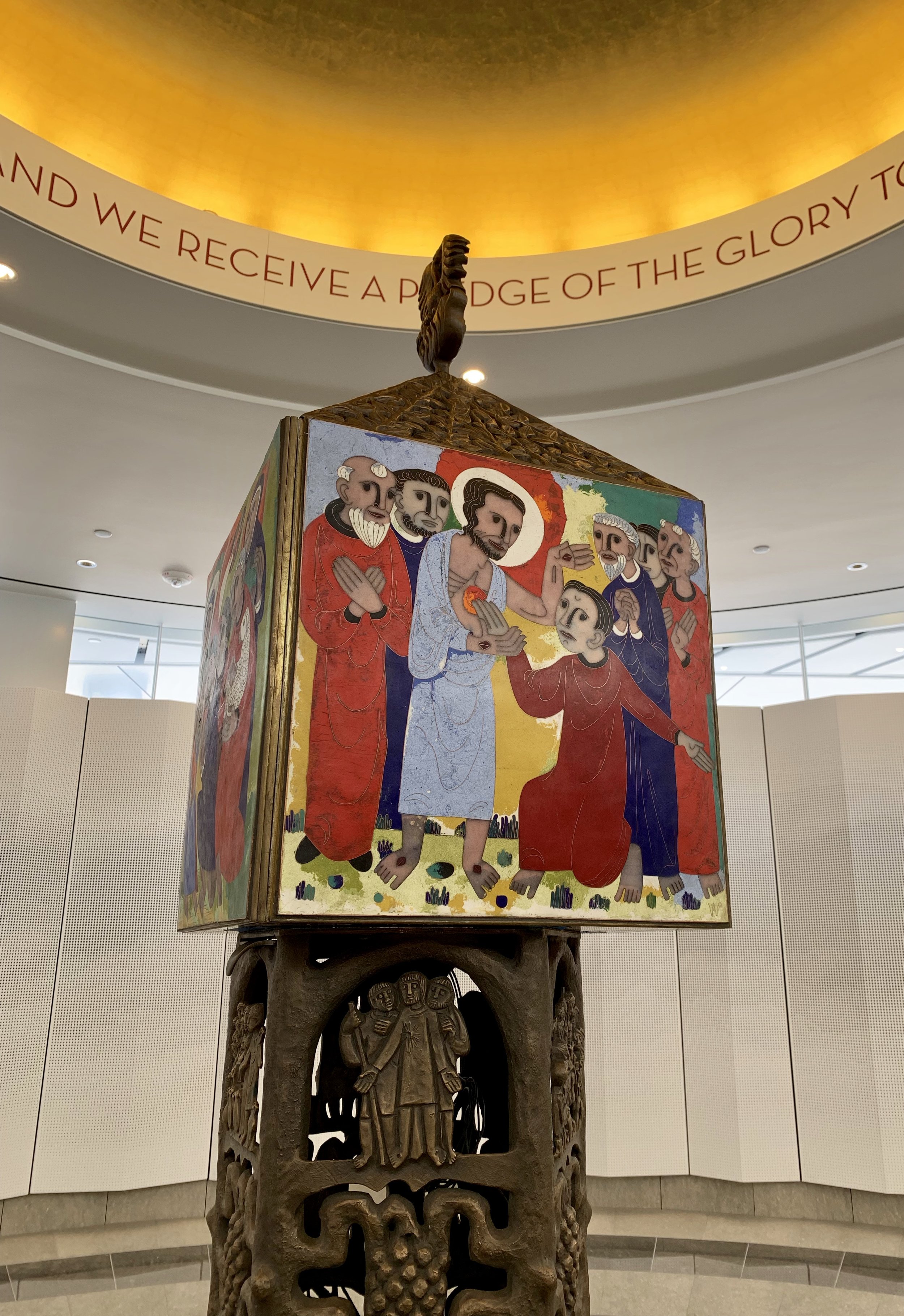
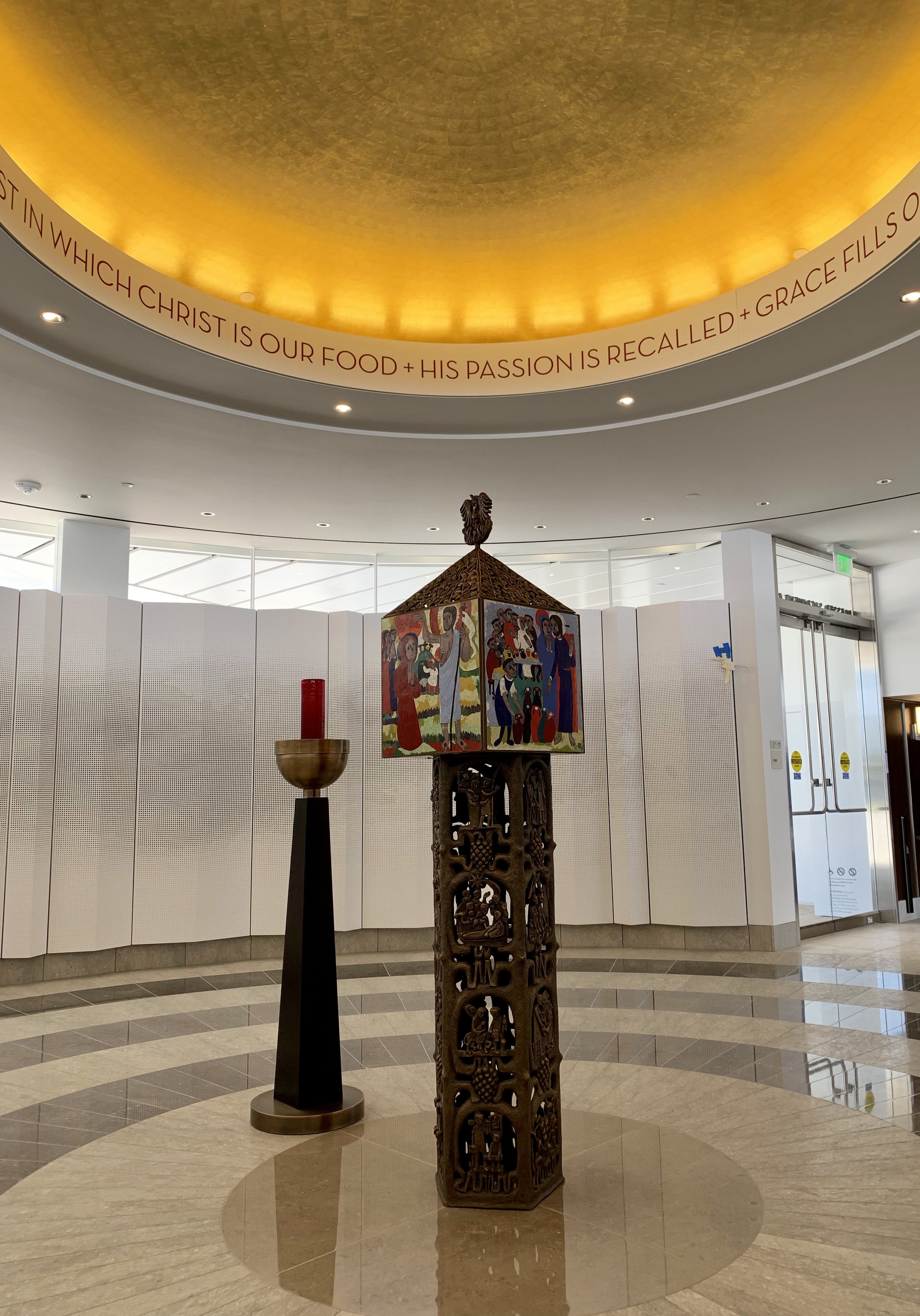

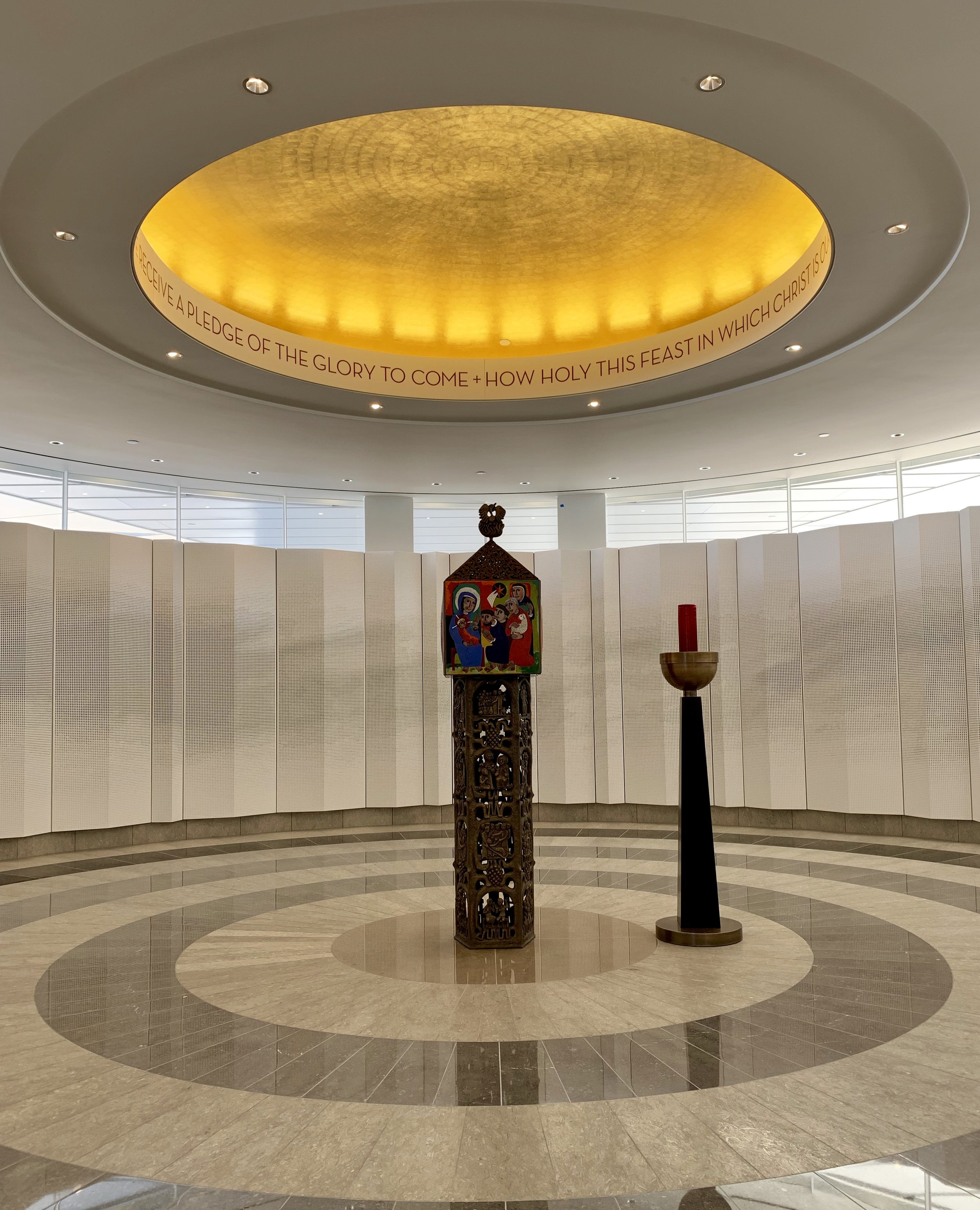
The following video gives a more detailed explanation of the Weinert Tabernacle and its meaning within Christ Cathedral. The video was produced prior to the repositioning of the Sacrament Chapel to the East of the Cathedral proper.
Universal Quatrefoil System
In order to address the multiple challenges of the glass space frame historically inherent with the Johnson structure, an interior “second skin” for the new Christ Cathedral is constructed, comprising of what is referred to as a universal quatrefoil system. Four-part triangular translucent “petals” have been designed to cover the entire interior of the existing space frame addressing an array of challenges which the existing building posed for both environmental comfort and the gracious celebration of the Liturgy. Some of the issues in question were:
Solar heat: the petals deflect solar heat gain back into the environment rather than into the interior.
Glare: the translucent panels will diminish the amount of direct natural light into the sanctuary.
Natural ventilation: the space between the panels and the space frame forms a ventilation flue.
Acoustics: the petals are oriented in multiple directions, reflecting and dispersing sound.
Night illumination: In combination with artificial light, the surfaces of the petals will provide uniform lighting.
Integration: the petals will diffuse interior light throughout the entire sanctuary and diminish strong shadow lines currently falling on congregants and the sanctuary floor.
Organ: the petals will act as a “sound cloud” for the reflection of organ music into the volume of the sanctuary.
Within the square grid of each quatrefoil, the triangulated petals have been programmed to be variously closed, 15 degrees open, 30 degrees open and 45 degrees open. The surface of the Cathedral has been digitally mapped to identify the location of the sun during all periods of the day throughout the year. Where direct sun is deemed to be problematic due to glare, closed pedals are located while in areas where glare is not an issue, the pedals are designed to be in varying stages of openness. These various conditions are then randomized to create a singular tapestry of white, translucent skin inside the glassy exterior shell of the building. By balancing the light, all attention will be directed to the liturgical action at the altar, the supreme liturgical focus for Catholic worship. It is the hope of the design team that this unique solution will be a joyful nexus of worship, art and science. An added benefit will be a dramatic evening illumination of the Cathedral as seen from the Cathedral close.
In the undercroft there will be an ancillary chapel seating 250 as well as sacristies, choir rehearsal space, burial vault for the bishops of Orange as well as additional columbaria niches, restrooms and storage space will be located. At the present time, the full realization of the undercroft area, specifically its chapel, will be part of Phase II of Cathedral construction.
Baptistery
The Baptistery is structured in the traditional eight-sided manner. The sunken cruciform baptismal pool with three steps from the West, leading down into the water and three steps leading out into the East will be ornamented with a simple Chi-Rho design together with the Greek letters, “Alpha and Omega.” The Holy Oils will be enshrined in this area as well as a catafalque for the placement of a coffin in vigil. Emerging out of the baptistery into the Cathedral proper will be the Reconciliation rooms to highlight this sacrament as that of ‘second’ baptism.
Cathedral Close
The renovated Cathedral will be surrounded by a completely redesigned plaza or “Cathedral close.” Bordered by greenery and lush landscaping, this exterior threshold symbolically will create the beginning transition from the marketplace into the area of sacred space.
Architectural exterior lighting and accommodation for sound will delineate areas for the blessing of the great Easter fire, devotional shrines as well as areas for quiet contemplation, gathering areas for meals and receptions together with accommodation for gatherings of over 5000 for outdoor celebrations.
Restoration of the Hazel Wright Organ
Shortly after the acquisition of the Crystal Cathedral property by the Diocese, representatives of the Fratelli Ruffatti organ company in Padua, Italy, met with Diocesan officials and consultants to assess the condition of one of the properties most valued musical assets, the Hazel Wright Memorial organ in the Philip Johnson Cathedral. Originally installed in 1982, the instrument was the amalgam of several existing instruments augmented and consolidated by the Ruffatti company. In its final configuration it comprised of 270 ranks with 16,061 pipes and is considered one of the ten largest pipe organs in the world.
Since its installation in 1982 and due to exposure to the elements as well as temperature variations occasioned by the lack of temperature control in the cathedral, the instrument needed a thorough renovation as well as upgrades in digital technology that has experienced substantial advancements over the intervening years.
The restoration took over 2 years with work being done both in Padua, Italy and locally. Part of the restoration was the complete refurbishing of the original principal organ console as well as that of an ancillary console originally built by the Möeller organ company to be position in the south gallery.
Bishop Vann at the Fratelli Rufatti factory in Padua, Italy
The reinstallation and voicing of the newly restored instrument which is presently underway, will take approximately one year, augmented by a number of digital ranks by the Walker organ company.
The organ will be blessed and rededicated on May 15-16-17, 2020. For complete details on the Hazel Wright Pipe Organ celebrations see ChristCathedralMusic.org.
Primary console restored
Secondary console restored
Shrine to Our Lady of LaVang
The Diocese of Orange is blessed with a large Vietnamese population many of whom settled in the County as refugees following the Fall of Saigon in 1975. To honor their pivotal devotion to Our Lady of LaVang, a magnificent outdoor shrine in her honor will grace the Cathedral Close in the coming year.
Conclusion
Responding to the question, “What elements create sacred space?,” Duncan Stroik, the revivalist champion for classic church architecture, has stated that sacred buildings have verticality to emphasize the important dimension of transcendence, they have directionality, starting at one point and leading to another; they have solidity and stability, made out of fine materials that will last for centuries and finally they have iconography and sacred imagery that we can relate to, that tells a story that we can identify with.
It is our hope that the dramatic verticality of this renovated structure will indeed raise our hearts and minds to the God who lives in unapproachable light yet dwells among us in bread broken and cup shared. From whatever threshold one enters, the clarity in directionality will bring one to the Table of Grace and blessing. While one may not think of glass as a material of solidity and stability, perhaps we need only think of Sainte Chapelle and its enduring beauty.
And finally, images of the sacred and the holy help us to remember that in our places of worship, heaven is indeed wedded to earth.








